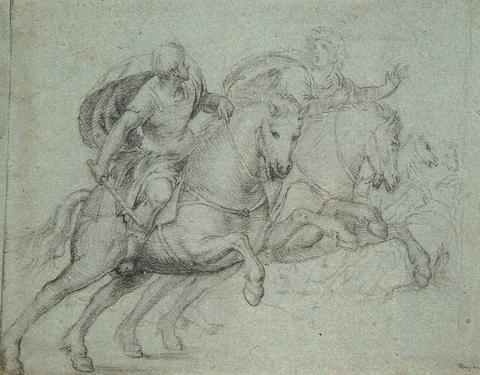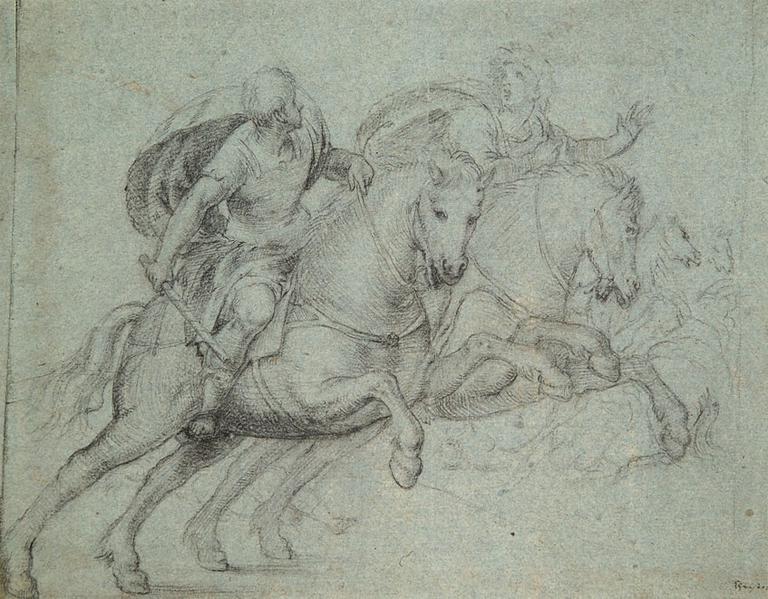
Cavalcade
Giovanni Antonio de Sacchis, dit Pordenone (1483 Corticelli - 1539 Ferrare)
1520 - 1525
Crayon noir sur papier préparé bleu ; inscription illisible à la plume et encre brune en bas à droite ; 17,4 x 22,2 cm
Provenance :
New York, Sotheby’s, 27 janvier 2010 (attribué à Pomponio Amalteo) ; Paris, collection Le Polyptyque ; Paris, collection privée.
Bibliographie :
Charles E. Cohen, « Drawings by Pomponio Amalteo », Master Drawings, vol. XI, n° 3, 1973 ; Charles E. Cohen, The Drawings of G. A. Pordenone, Florence 1980 ; Caterina Furlan, Il Pordenone, Milan, 1998.
Pordenone est dans la sphère vénitienne, pendant une génération, le rival malheureux de Titien. Son œuvre n’a pas eu de chance. Il a beaucoup peint à fresque, dans des églises de campagne ou la façade de palais. Les premières ont été souvent abîmées ou défigurées par les restaurations, les secondes effacées par le temps. D’où l’importance de ses dessins, qui figurent dans les plus grands musées. Il se trouve au Louvre un dessin d’un format proche et de la même technique, au crayon noir sur le papier bleu fréquent à Venise au 16ème siècle : un Homme nu tenant un livre, préparatoire à la façade du Palazzo Tinghi, à Udine, vers 1532.
On peut voir dans notre dessin, inspiré de l’antique (et probablement d’un sarcophage figurant le rapt de Proserpine), une cavalcade propre à orner la façade ou l’intérieur d’un palais, étude jetée sur le papier pour convaincre un commanditaire ou fixer une idée. D’abord attribué à Pomponio Amalteo, le gendre et l’élève de Pordenone, pourquoi le rendre au maître ? Reprenons les critères de qualité que l’historien d’art Jakob Rosenberg assignait au dessin ancien : la ligne « vibre » ; les formes et les plans sont clairement définis ; l’espace se déploie ; la composition est cohérente et dynamique. Au contraire les dessins d’Amalteo sont généralement appliqués. Il y manque, pour reprendre les termes de Charles E. Cohen, « la souplesse organique et la qualité rythmique dans le rendu des formes protubérantes » qui caractérisent les dessins de Pordenone, et celui-ci en particulier.
Cette « fougue » (un terme souvent employé s’agissant de Pordenone), néanmoins très maîtrisée, plus proche de la Renaissance classique que du Maniérisme, de Raphaël que du Tintoret, conduit à dater ce dessin après son voyage à Rome en 1516. Pordenone se souvient peut-être, dans le cheval et le cavalier du premier plan, de l'Expulsion d'Héliodore, la fresque de Raphaël dans les chambres du Vatican, le last but not least d'un art encore contemporain puisqu'elle daterait de 1512, et d'un artiste né la même année que lui.
C’est à cette fresque qu’il se mesure dans son œuvre majeure, Jésus conduit au Calvaire de la cathédrale de Crémone (1520), dont le cheval et cavalier de droite se rapprochent le plus de notre dessin. Plus tard, on retrouve un cavalier à la cape flottante, un cheval solidement calé dans le coin de la composition, dans le Saint Martin et Saint Christophe de l’église San Rocco, à Venise (1528-1529). Mais l’esprit n’est déjà plus le même, moins délié, plus contorsionné. C’est donc du début, ou du milieu, de la troisième décennie du siècle que l’on datera notre dessin.
